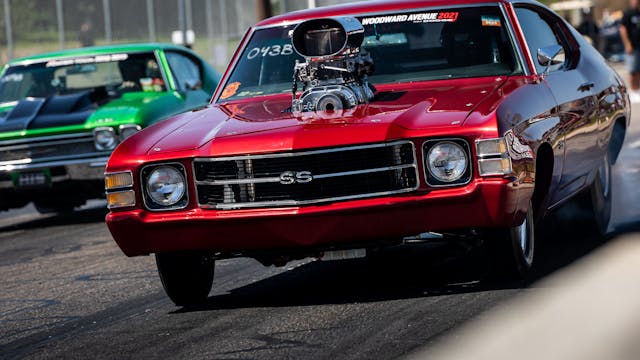Fabric-clad off-road EV sips biodiesel, RPM Act gears up in Senate, a T-bird with old-school Disney charm

Fabric-clad EV offroader hides range-extending biodiesel power
Intake: A pioneering new electric British truck designed by a former Formula 1 engineer claims a phenomenal 4000-plus-mile range. The Fering Pioneer from ex-Ferrari and -McLaren man Ben Scott-Geddes uses two electric motors—one on each axle—to provide all-wheel-drive and a total of over 440 lb-ft of torque to give it serious off-road chops. The battery pack features lithium-titanate-oxide cells, instead of the more conventional lithium-ion type, as they are designed to survive more extreme weather conditions.
The truck is built on an aluminum spaceframe with composite parts and the bodywork is actually a canvas material similar to that used in hiking boots. Fering says this unusual material shrugs off damage, is easy to replace and provides better insulation than metal. Using this combination the dry weight of the Pioneer is just 3300 lbs. The Pioneer is small by U.S. standards, at around ten inches shorter than a Toyota Tacoma, but it has a massive driving range thanks to a range extender engine. This three-cylinder 800-cc unit, which runs on biodiesel, keeps the batteries topped up when the vehicle’s pure plug-in range of 50 miles has been reached. Fitted with long-range fuel tanks the Pioneer can apparently travel 7000 km (4350 miles) before needing to refuel. The Pioneer has also been designed to accept bigger batteries or use an alcohol-fueled engine instead of the diesel motor so that it can be adapted for use around the world. Currently undergoing testing, production is set for the first half of 2022.
Exhaust: Well, the name’s certainly right. This truck is definitely a Pioneer. There’s some really radical thinking gone into making it fit for purpose. Target customers are “lifesavers not lifestyle” with emergency services already assessing the truck and potentially pitting it against the upcoming Ineos Grenadier.
RPM Act is reintroduced into the Senate

Intake: After gaining support in the House of Representatives (which reconvenes September 20), the bipartisan Recognizing the Protection of Motorsports (RPM) Act has been reintroduced into the U.S. Senate. Passage of the bill—a response to the Environmental Protection Agency’s 2016 declaration that these vehicles violate the Clean Air Act—is critical to ensuring that racers can continue to modify street vehicles into race cars used exclusively in competition and that businesses can continue to produce, market, and install racing equipment. According to Performance Racing Industry, federal lawmakers have received more 1.5 million letters urging them to pass the bill in 2021.
Exhaust: With overwhelming public and political support, the RPM Act continues to gain steam, and we may soon see a conclusion to enthusiasts’ fight to legally customize and race street cars.
Porsche plants the seed for eFuel in Chile

Intake: The world’s first almost carbon-neutral eFuel factory is under construction by Porsche and Siemens Energy in Chile. The plant in Punta Arenas, Patagonia, will produce 130,000 liters (over 34,000 gallons) of near-carbon neutral fuel in 2022. Its capacity will be rapidly ramped up to 55 million liters (14. 5 million gallons) by 2024, and 550 million liters (145 million gallons) by 2026. Powered by wind energy, the plant will create its synthetic fuel by combing hydrogen generated from electrolysis with carbon dioxide captured from the atmosphere. Some of the first eFuel produced will power Porsche Supercup racing from 2022.
Exhaust: Porsche says that by using this eFuel, carbon-dioxide emissions from combustion engines can be reduced by up to 90 percent, extending the life of internal combustion. Earlier this year, Mazda became the first automaker to join the eFuel Alliance, and support for greener, alternative fuels to serve alongside electrification is growing. Good news for gearheads.
No ’57 T-bird packs unique, old-school Disney charm like this one
Intake: Actress/singer Annette Funicello was only 12 years old when, in 1955, she was personally selected by Walt Disney to join the cast of The Mickey Mouse Club television show. She quickly rose to stardom, and her father purchased a new 1957 Ford Thunderbird for her before she was old enough to drive it herself. That gorgeous red T-Bird, powered by a 312-cubic-inch V-8, is a hot commodity on Bring a Trailer. UPDATE: When the (virtual) hammer dropped, this T-bird had soared to $150,000.
Exhaust: Annette Funicello was the “it” girl of the teenage set in the 1950s and ’60s, first on The Mickey Mouse Club and later in a series of Beach Party movies with Frankie Avalon. There are plenty of sweet ’57 Thunderbirds out there, but this one’s connection to Funicello and Disney’s glory years on television make it irresistible to Baby Boomers. The seller may soon be singing, “M-I-C … K-E-Y … M-O-N-E-Y.”
GM Defense nabs government contract for heavy-duty Suburbans

Intake: As part of a new $36.4 million development contract with the U.S. Department of State, GM Defense will create a purpose-built heavy-duty version of the Suburban. The HD Suburban will get a new and unique frame and suspension to accommodate additional weight from special equipment such as body-armor and other protection tech. So far there’s no word on whether the new chassis will use an independent rear setup as with the civilian version or revert to the solid axle of past models. The body and powertrain components should be standard, off-the-shelf Suburban components. Deliveries will begin next spring, and GM Defense is expecting an additional contract to build 200 HD Suburbans a year for the next nine years.
Exhaust: Optimistically, we’re hoping that out of this development project, a path forms for a general public-facing Suburban HD. Regardless, we’re entirely unsurprised to see the new Suburban pressed into governmental service. Its size, ruggedness, and spaciousness make it the perfect vehicle for transporting high-priority officials—as well as the perfect platform to slap a bunch of armor on and build a low-profile beast of a transporter.








